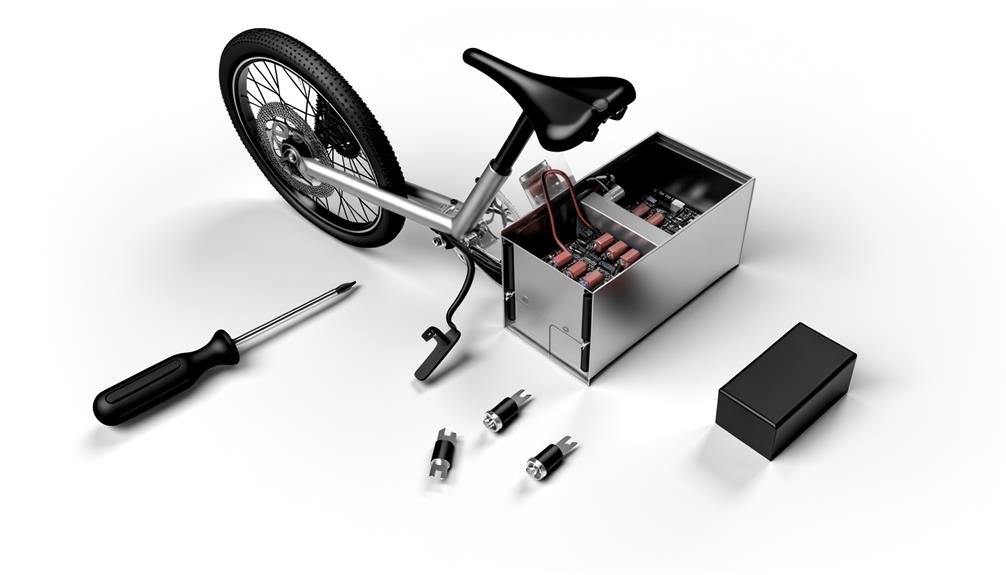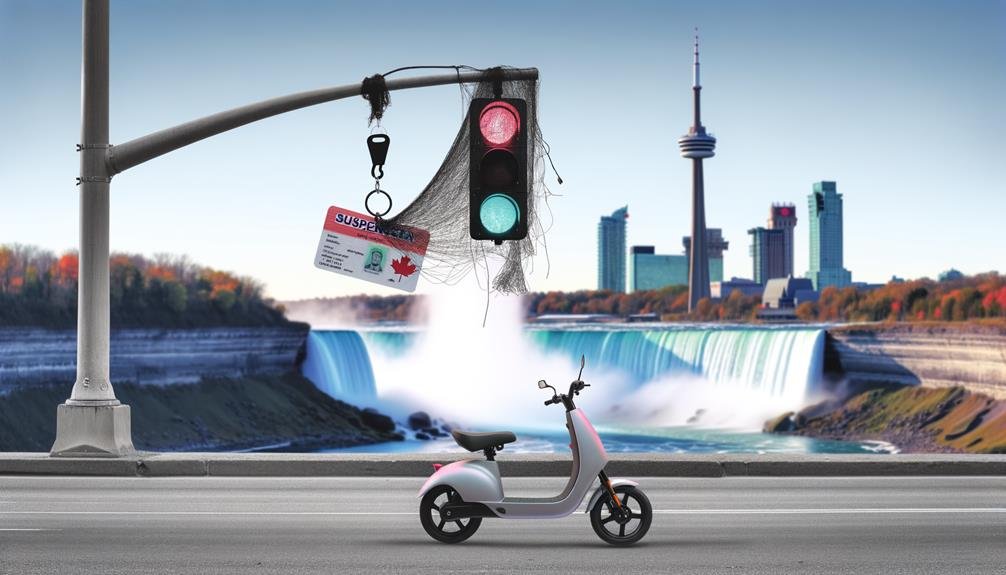Charles Miller is a veteran bike enthusiast with over 12 years of experience dealing with bikes as a mechanic. Despite immense love and expertise for...
Imagine pedaling down a sun-dappled trail, the wind in your hair, your electric bike humming beneath you. Suddenly, your e-bike's battery light starts blinking – you're running low on power. You're miles away from home.
Wouldn't it be great if you could just pull out a portable charger and replenish your bike's battery? Yes, you can, but it's not as straightforward as charging your smartphone. There are factors to consider such as the type of charger, its compatibility with your e-bike, and how much power it can deliver.
Stick around and we'll explore this intriguing possibility further.
- Key Takeaways
- Understanding Electric Bike Batteries
- Portable Chargers: An Overview
- Compatibility of E-Bikes and Portable Chargers
- Charging E-Bikes On-the-Go
- Solar Chargers and E-Bikes
- Using Car Battery Inverters
- Generator as an Alternative
- Off-Grid E-Bike Adventures
- Potential Challenges and Solutions
- E-Bike Conversion Kits Review
- Frequently Asked Questions
- Conclusion
Key Takeaways
- E-bike batteries typically have a capacity of 500Wh or more, while portable chargers usually have a capacity of around 100Wh. This means that power banks may not meet the power demands of electric bikes.
- Carrying a spare e-bike battery is a straightforward solution to extend the range of your electric bike.
- Inverters can be used to charge e-bike batteries via a car's 12V outlet, providing a practical and convenient charging option.
- Solar chargers are a viable solution for charging e-bike batteries on-the-go, drawing energy from the sun and offering a portable and environmentally friendly charging option.
Understanding Electric Bike Batteries
To fully grasp the concept of charging your electric bike with a portable charger, it's vital to first understand the basics of e-bike batteries and their inherent limitations. Your e-bike battery typically has a capacity of 500Wh or more, dwarfing the average power bank's capacity of around 100Wh. This discrepancy hints at the challenges of charging your electric bike on the go.
So, what're your alternatives? The most straightforward solution is carrying a spare ebike battery. However, with prices ranging from $900 to $2000, and compatibility issues to consider, this option mightn't be feasible for every rider. Another method involves using inverters to charge your ebike battery via a car's cigarette lighter or auxiliary 12V outlet.
But there's a catch. You'll need to consider certain factors like potential efficiency losses, actual usable capacity, and the necessity for DC-to-DC converters. Alternatively, automotive 12V AGM batteries offer a higher capacity and usable charge compared to typical power banks.
Understanding electric bike batteries and their charging options is your first step towards a more sustainable and convenient riding experience. Now, you're part of the conversation.
Portable Chargers: An Overview
Now that you've got a grip on the basics of e-bike batteries, let's dissect the concept of portable chargers and their role in powering your electric bike on the move. Portable chargers, or power banks, typically boast a capacity around 100Wh. This mightn't seem like much, especially when you consider that most e-bike batteries demand 500Wh or more.
However, don't lose heart. You've got alternative options to extend your e-bike battery range on those long, winding trips. Here are a few:
- Carry a spare e-bike battery, ensuring you won't be left high and dry.
- Use inverters with your car's 12v outlet, a handy alternative if you're traveling with your vehicle.
- Consider your bike's specific compatibility and storage needs, as these can affect the efficiency of charging.
Compatibility of E-Bikes and Portable Chargers
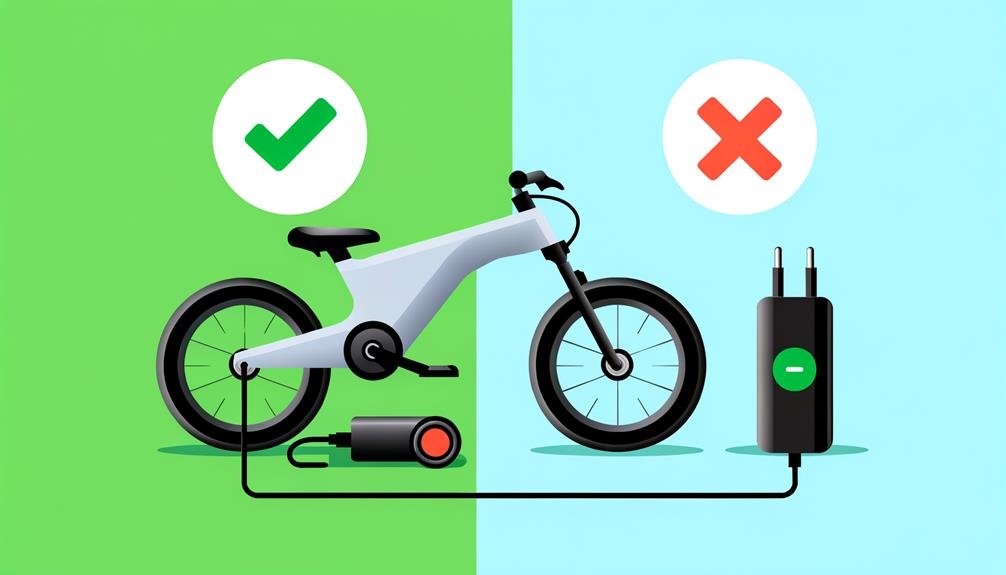
When it comes to charging your e-bike with a portable charger, it's essential to consider the compatibility between the two devices. Not all portable chargers are built the same, and not all can meet the power demands of electric bikes.
Typically, portable power banks have a capacity of around 100Wh, while most e-bike batteries require 500Wh or more. Consequently, a power bank may not extend an e-bike's range significantly on a long trip. Your best alternative options are carrying a spare e-bike battery or using inverters to charge from a car's 12V outlet.
However, remember that spare e-bike batteries can be expensive and may come with specific compatibility limitations. Here's a quick comparison:
| Portable Charger | Spare Battery | Car Inverter | |
|---|---|---|---|
| Power Capacity | Low (100Wh) | High (500Wh) | Varies |
| Price | Low | High | Moderate |
| Compatibility | Limited | Specific to e-bike | Wide |
The compatibility of e-bikes and portable chargers is crucial to understand. Portable chargers may not be designed for e-bike batteries' specific voltage and charging requirements, resulting in limited efficiency. So, before you set off, ensure your charging solution is compatible with your e-bike.
Charging E-Bikes On-the-Go
Navigating the challenges of charging your e-bike on-the-go requires understanding the capabilities and limitations of various charging options. Whether you're cruising city streets on your electric bike or tackling steep slopes on your mountain bike, access to portable power is crucial.
- Portable Power Banks: These offer an accessible solution for charging e-bikes on-the-go. However, their lower capacity compared to e-bike batteries may limit their utility. You'll need to consider efficiency, cost-effectiveness, and voltage requirements when choosing a power bank.
- Spare E-Bike Batteries & Inverters: Carrying a spare e-bike battery can extend your range on long trips. Inverters in vehicles can also be used for charging, but remember to check for compatibility and cost.
- Alternative Power Sources: AGM batteries and solar chargers offer alternative power sources. Solar chargers, in particular, are an eco-friendly solution, providing renewable energy wherever sunlight is available.
When selecting your charging solution, consider your individual needs and the nature of your ride. With the right knowledge and tools, you'll belong to the growing community of riders who enjoy the convenience and sustainability of e-bikes without worrying about running out of power.
Solar Chargers and E-Bikes
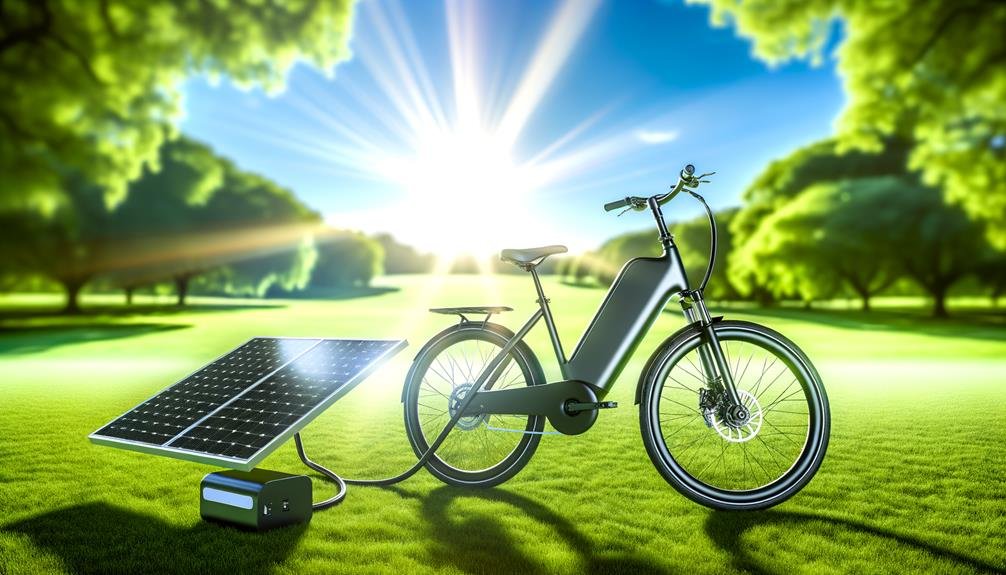
Building on the concept of alternative power sources, let's explore the practicality and potential of solar chargers for energizing your e-bike. Solar chargers, particularly those equipped with solar panels, draw energy from the sun, converting it into electricity which can then be used to power your e-bike.
Given the typical portable power bank's capacity of around 100Wh, solar chargers may offer a more viable solution. However, it is crucial to acknowledge the limitations of these devices. For one, the rate of solar charging can vary greatly depending on the amount of sunlight available.
Here's a quick comparison:
| Solar Charger Advantage | Solar Charger Limitation |
|---|---|
| Environmentally friendly | Dependence on sunlight |
| No running cost | Slow charging rate |
| Portable | Less reliable in cloudy weather |
While solar chargers offer an eco-friendly alternative, the practicality of their use depends on your specific needs and circumstances. If you're frequently on long trips or in areas with limited access to power outlets, incorporating a solar charger could be a beneficial addition to your e-bike setup.
Using Car Battery Inverters
Switching gears, let's delve into how you can use car battery inverters to charge your e-bike's battery on the go. Car battery inverters offer you a practical and convenient way to ensure your e-bike is always ready for the road.
Here are three key steps you need to follow to successfully charge your e-bike using a car battery and an AC inverter:
- Firstly, plug your AC inverter into your car's cigarette lighter or auxiliary 12v outlet.
- Next, you should connect your e-bike's charger to the AC inverter. For proper operation, it's recommended to use a true/pure sine wave inverter.
- Lastly, ensure your e-bike battery is securely and stably mounted to prevent damage while the vehicle is moving.
Keep in mind that some vehicles, especially heavy-duty pickups with plow packages, may come with built-in inverters, making the process even more convenient.
Generator as an Alternative

While car battery inverters offer a handy solution for charging your e-bike, you shouldn't overlook the possibility of using a generator as a reliable alternative power source. A generator can be a game changer when you're camping off-grid or simply looking to extend your e-bike's range on long trips.
To use a generator, you'll simply plug your e-bike charger into the generator, just like you'd do at home. Here's where it's crucial to ensure the generator's power capacity matches your e-bike's lithium battery requirements. This means checking the power output rating on the generator and ensuring it's suitable for your e-bike's charging needs.
Now, you might be wondering, 'How long will it take to charge my lithium battery with a generator?' The answer depends on your specific battery and generator, but generally, it shouldn't take longer than charging at home.
Remember to always follow safety guidelines while using generators. Proper ventilation is a must to avoid any hazardous situations.
Off-Grid E-Bike Adventures
In the midst of wilderness, charging your e-bike can pose unique challenges, particularly when you're far from a traditional power source like a wall outlet. Yet, you can't let power limitations deter your off-grid adventures.
- Portable power banks: While a useful resource, they may not deliver sufficient charge due to their lower capacity. You'll also need to be aware of potential efficiency losses and the requirement for DC-to-DC converters to minimize these losses.
- Spare e-bike batteries: Carrying extras is a viable option. However, they come with high costs and compatibility limitations. Choose capacity based on your needs.
- Inverters: You can use inverters to charge e-bike batteries from a car's auxiliary outlet. Vehicle-specific built-in inverters could also serve as an alternative.
Another solution is to use automotive 12V AGM batteries. They're sealed, designed for deep cycle use, and can be a more affordable option for extending e-bike battery range.
Potential Challenges and Solutions
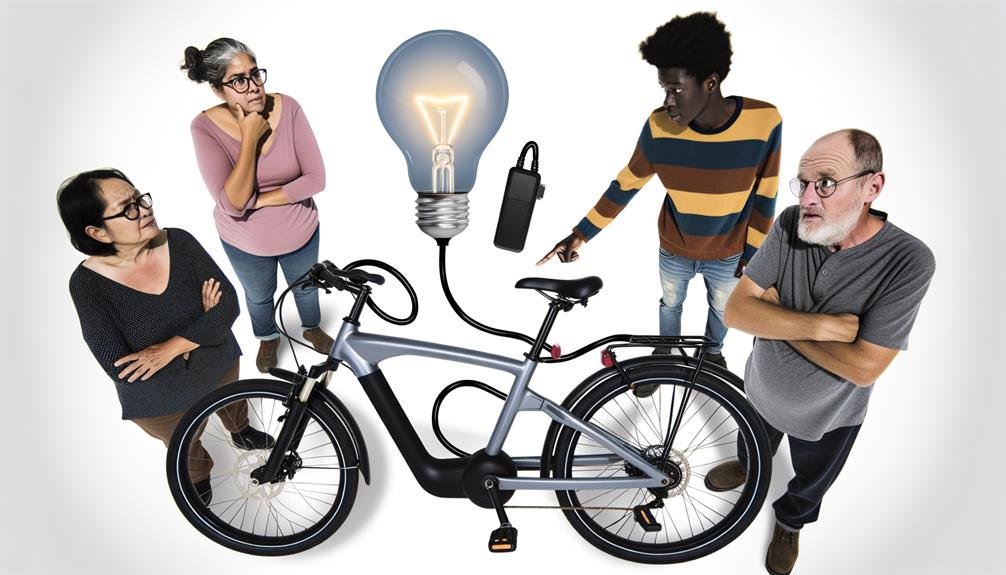
Navigating the challenges of charging your e-bike on the go, you'll need to consider the limitations of portable power banks, the high cost and compatibility issues of spare batteries, and the efficiency of inverters connected to a car's 12V outlet.
Typical power banks max out at around 100Wh, insufficient to fully charge an e-bike battery which usually has a capacity of 500Wh or more. A potential solution is to carry spare batteries, but these bring their own challenges – high cost, compatibility issues with your e-bike model, and the additional storage required.
Alternatively, you can connect an inverter to your car's 12V outlet, but the efficiency losses and voltage requirements may not make this the most viable option.
To overcome these potential challenges, consider using a 12V AGM battery from a car. These provide higher capacity and offer a more affordable solution.
E-Bike Conversion Kits Review
Now, let's turn our attention to E-Bike conversion kits.
You'll need to understand what these kits are, how to install them, and tips to ensure a smooth process.
Lastly, we'll guide you on choosing the right kit that suits your specific needs.
Understanding E-Bike Conversion Kits
Before diving into the world of e-bike conversion kits, it's crucial to understand their efficiency, limitations, and alternatives.
E-bike conversion kits can transform your conventional bicycle into a powerful electric one.
- Efficiency: E-bike conversion kits are cost-effective and efficient, offering a comparatively easy way to upgrade your bike. They often include everything you need, from the motor to the controller and throttle.
- Limitations: Despite their advantages, these kits have limitations. The overall performance depends on your bike's original specifications, and not all bikes may be compatible.
- Alternatives: If a conversion kit isn't suitable, consider purchasing an e-bike with a built-in electric system or exploring portable power banks as charging options.
In essence, understanding e-bike conversion kits is a step towards enhancing your cycling experience.
Installation Process and Tips
When you're ready to install your e-bike conversion kit, it's crucial to first ensure its compatibility with your current bike's frame and components.
Begin the process by removing your front wheel and replacing it with the motorized one from the kit.
Attach the controller and battery pack as per the manufacturer's instructions. Make sure all components are securely installed to avoid safety hazards.
Always check all connections, ensure proper wiring, and test your brakes and throttle before embarking on your first ride.
If you're uncertain about any step, seek professional help.
Choosing the Right Kit
In choosing the right e-bike conversion kit, it's vital to understand the limitations of portable power banks for charging e-bike batteries. You should be aware that:
- Not all power banks can provide the necessary voltage for e-bike batteries.
- Charging times can be longer with power banks than conventional sockets.
- Some power banks may not have the necessary capacity for a full e-bike battery charge.
When picking your kit, consider the efficiency, your travel needs, and the possible need for spare batteries. Exploring alternative power sources, like solar chargers, could also be beneficial.
Frequently Asked Questions
How Can I Charge My Ebike When Camping?
Yes, you can charge your e-bike while camping. Look into solar charging options, they're portable and efficient. It's a great way to make sure you've always got power, even off the beaten path.
How Do You Charge an Ebike While Traveling?
Yes, you can use a portable charger to juice up your e-bike while traveling, but it's not ideal. It's better to carry a spare battery or use an inverter with your car's 12V outlet.
Can I Charge an Ebike With a Power Station?
Yes, you can charge your e-bike with a power station. Be sure it's got enough capacity and matches your bike's requirements. Remember, power station efficiency is key for a successful, quick charge.
Can a Jackery 500 Charge an Ebike?
Yes, you can charge an eBike with a Jackery 500. However, it's not the most efficient method due to power losses in conversion. You'd be better off with a spare eBike battery for longer trips.
Conclusion
In a nutshell, yes, you can indeed charge your e-bike with a portable charger. Whether you're using a solar generator like Jackery or a standard portable charger, you're all set for those off-grid adventures.
Just remember, compatibility and power requirements are key. So, embrace the green energy, enjoy the ride, and never worry about running out of juice.
After all, with a portable charger, your e-bike's battery life is literally in your hands.

Charles Miller is a veteran bike enthusiast with over 12 years of experience dealing with bikes as a mechanic. Despite immense love and expertise for his Tacoma, he rides his Trek Ebike more. Anytime you meet him, you’ll either hear him talking about Bikes, or writing about all things bikes and cars on this blog.
More Posts
